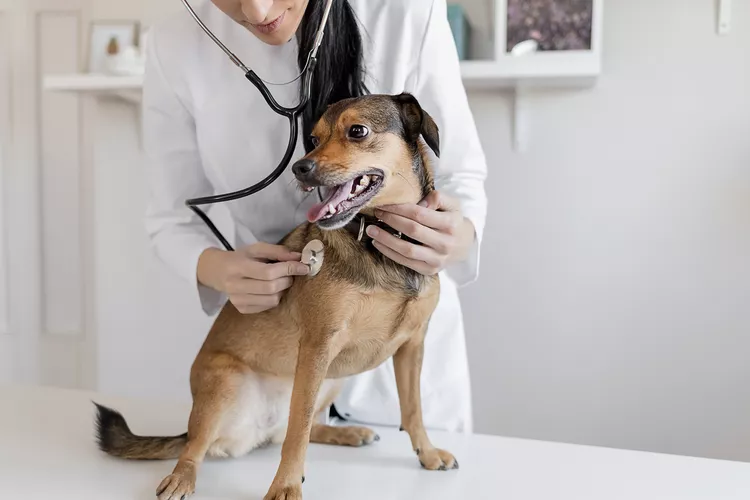Vaginitis in Dogs

Vaginitis in dogs is the inflammation of the vagina that typically causes redness, swelling, itching or pain, and vaginal discharge. Vaginitis can occur in any female dog, spayed or not, and it usually requires veterinary treatment. Because vaginitis can be a symptom of external irritating factors or underlying problems, delaying a visit to the vet can make matters worse. Discover the symptoms and causes of vaginitis in dogs and know when to call your veterinarian to seek treatment.
What Is Vaginitis in Dogs?
Vaginitis in dogs is a complex condition that causes inflammation of a dog's vaginal tissues. There are technically two types of vaginitis in dogs:
- Puppy vaginitis is seen in intact, young female dogs before the onset of puberty.
- Adult-onset vaginitis occurs in adult female dogs. It can affect intact females but is more common in spayed dogs.
Vaginitis can be triggered by several different conditions, external and internal, but the irritating symptoms always indicate a problem that requires investigation.
Symptoms of Vaginitis in Dogs
Dogs with vaginitis may experience several symptoms, the most common of which include:
- Inflamed/swollen vaginal area
- Surrounding tissue redness
- Abnormal vaginal discharge
- Increased urination
- Excessive licking of the vaginal area due to pain or itching
- Rear-end scooting or dragging
An inflamed vaginal area is a key indicator that a dog has vaginitis. Vaginal redness or swelling can be more difficult to notice in a furry dog, so you may need to take a closer look if you suspect problems in that area.
A dog with vaginitis will often lick the surrounding area obsessively or drag her rear end across the floor in an attempt to soothe the itching and burning discomfort. She may also feel the need to urinate more often.
Pus or mucus may leak from the dog's vagina—on her fur, the floor, bedding, or furniture where she lays. This discharge may be blood-tinged. If a spayed dog, or an intact dog that is not in heat, experiences vaginal discharge, a veterinary visit is necessary to determine the cause.
While some of these signs can be easily confused with heat cycles in intact dogs, attentive owners will soon recognize the behavioral differences between heat and vaginal problems. When in doubt, it's best to contact your veterinarian.
What Causes Vaginitis in Dogs?
Many things can cause vaginitis in dogs, but they all create conditions in which vaginal irritation persists and becomes problematic. Some of these include:
- Urinary tract infections
- Bacterial, viral, or fungal infections
- Unsanitary conditions resulting in fecal material near the vaginal opening
- Urinary incontinence, which creates chronic, irritating moisture
- Birth defects (such as ectopic ureters or other malformations)
- Vaginal tumors or cysts, both benign and malignant
- Foreign bodies (such as grass seeds, foxtails, or other materials that can enter the vagina)
- Vaginal trauma (this includes mating)
How Do Vets Diagnose Vaginitis in Dogs?
If you suspect that your dog has vaginitis, your veterinarian will perform a physical examination, which may include looking inside the vagina with a scope. Next, they may collect a urine sample for a urinalysis. Your vet may also take a sample of the discharge inside the vagina using a cotton swab. Cells from this swab will be smeared on a slide for examination under a microscope to look for signs of infection, inflammation, and other abnormalities. Based on the cytological results, bacterial culture lab tests and other diagnostics may be necessary to pin down the definitive cause.
How to Treat Vaginitis in Dogs
Treatment of vaginitis in dogs depends on the severity and underlying cause. Your veterinarian may recommend one or more of the following:
- Antibiotics to fight infection
- Anti-inflammatory medications, such as carprofen, to relieve pain and swelling
- Medicated topical solutions to apply to the vaginal area
- Surgery if there is a tumor, cyst, foreign body, or congenital defect present
Regardless of the cause, most dogs with vaginitis will need to wear a cone to prevent licking of the vulva during treatment, which can delay recovery.
Prognosis for Dogs with Vaginitis
Most cases of vaginitis are not serious and will resolve with medication as long as the cause of the condition is addressed. The prognosis for a dog with vaginitis caused by a tumor is dependent on the size of the tumor, whether it is cancerous, and if it can be surgically removed without complication.
How to Prevent Vaginitis in Dogs
The best way to prevent your dog from developing vaginitis is to ensure her vaginal opening is always clean. Dogs with short fur don't usually need a lot of help with this. However, if your dog has long fur, is overweight, or has an anatomical malformation of the rectal or vaginal areas, help may be warranted. If necessary, keep fur trimmed and use a baby wipe after your dog pees or poops to remove urine and fecal debris from the vaginal opening.
It's also important to visit your veterinarian for routine wellness checkups, typically once or twice per year. Your vet may detect minor signs of vaginitis before your dog even shows signs. And, as always, be sure to contact your vet at the first sign of illness in your dog.